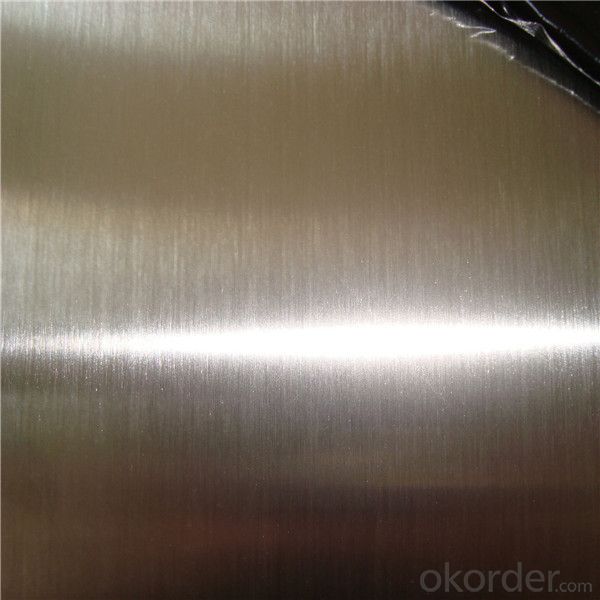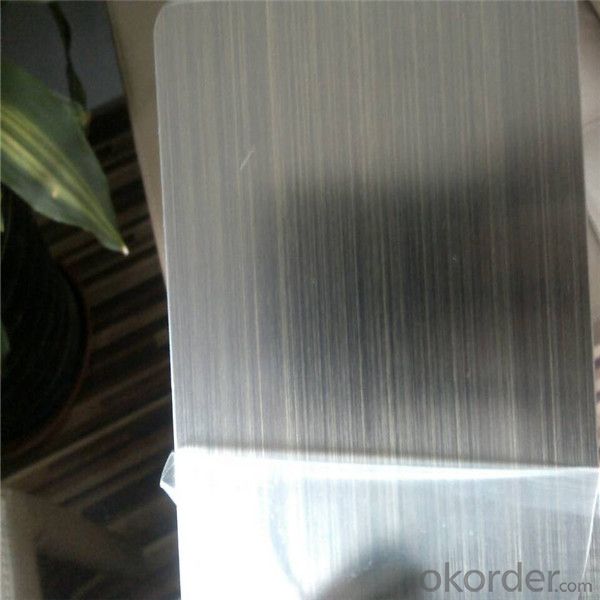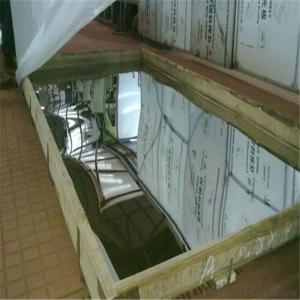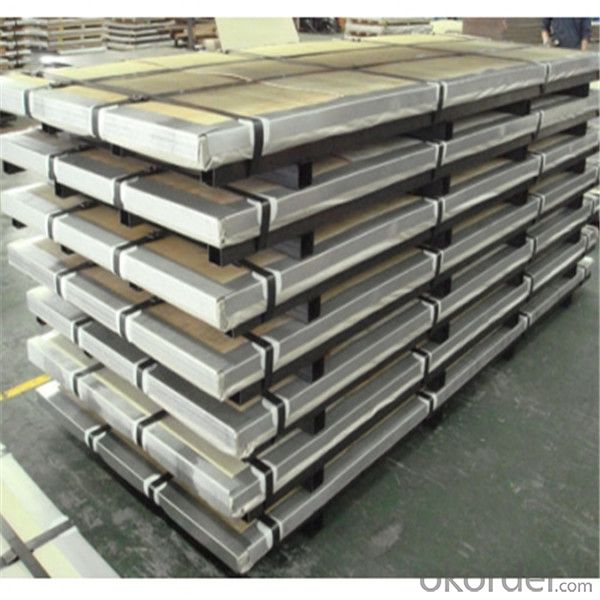309 Stainless Steel Plate China Mill price
- Loading Port:
- Shanghai
- Payment Terms:
- TT OR LC
- Min Order Qty:
- 3 m.t.
- Supply Capability:
- 30000 m.t./month
OKorder Service Pledge
OKorder Financial Service
You Might Also Like
Item specifice
309 stainless steel plate China Mill price

Product Description
Thickness: 0.3mm-3.0mm (Cold Rolled Stainless Steel Plate)
3mm-100mm (Hot Rolled Stainless Steel Plate)
Width:500mm, 1000mm,1219mm,1250mm,1500mm,
Length: 500mm,2000mm,3000mm,2438mm,as customer requirement
1) Material :
200 Series:201, 202
300 series:301,302,303,304,304L,304H,304N,305,309,309S,310,
310S,316,316L,316Ti,317,317L,321,321H,347M347H
400 series: 408,409,410,416,420,430,436,439,440,441,443,444
600series:610,620,630
900series:904L
Duplex stainless steel :S32750,S31803,S31500,SAF2507,SAF2205,etc
2)Surface Finish: 2B/BA/8K/HL/NO.1/NO.3NO.8/ NO.4/6K/HAIR LINE
3)Standard: GB/T4237-2009
GB/T4238-2009
GB/T3280-2007
GB/T4237-2007
JISG4304-2005
JISG4305-2005
ASTM A240/240M-10
ASTM A240-05
4)Rolling Range: Thickness*Width*Length 0.3-100mm*500-4200mm*500-18000mm or as per your request
5)Packing: With paper rolled inside and with wooden pallets or PVC coating or customize packing Export standard package in bundled or as required.


Product Uses
Finish | Thickness | Characteristics |
No. 1 | 2.0mm ~12.0mm | Surface finished by hot-rolling, annealing and pickling, characterized by white pickled surface. |
2B | 0.3mm ~3.0mm | Finished by heat treatment, pickling after cold rolling, followed by skin pass line to be brighter. |
BA | 0.3mm ~1.5mm | Processed with bright heat treatment after cold rolling. |
No. 4 | 0.4mm ~3.0mm | Polishing with No. 150 to No.180 abrasives. The most popular finishes. |
HL | 0.4mm ~3.0mm | Finished by continuous polishing streaks by using abrasive of suitable grain size. |
SB | 0.4mm ~3.0mm | Polishing with No. 150 to No. 180 Scotch-Brite abrasives. |
Packaging & Shipping
- Q:What are the different types of stainless steel sheet finishes for pharmaceutical applications?
- Pharmaceutical applications commonly utilize various stainless steel sheet finishes, each designed to meet specific requirements and provide certain characteristics and properties. 1. The most basic stainless steel sheet finish is No.1 Finish, with a rough and dull surface. It prioritizes corrosion resistance and durability over appearance. 2. No.2D Finish, also known as a "dull" finish, has a slightly smoother surface compared to No.1 finish. It is achieved through cold rolling and annealing, making it suitable for easy cleaning and maintenance in pharmaceutical applications. 3. No.2B Finish is highly popular in stainless steel sheets for pharmaceutical purposes. It boasts a smooth and reflective surface obtained through cold rolling, annealing, and pickling or passivating processes. No.2B finish offers exceptional corrosion resistance and easy cleaning properties. 4. No.3 Finish presents a semi-reflective surface with a slightly coarse texture. It is achieved by polishing the stainless steel sheet using a fine abrasive material. No.3 finish is commonly used when a decorative appearance is desired, while maintaining good corrosion resistance. 5. No.4 Finish is a favored choice for pharmaceutical applications that require both a decorative appearance and excellent corrosion resistance. It features a brushed appearance achieved by using a fine abrasive material in a linear motion. No.4 finish also provides a smooth surface that is easy to clean. 6. No.6 Finish, achieved by using a fine abrasive material in a circular motion, results in a satin-like appearance. It is often utilized in pharmaceutical applications where a high-quality aesthetic finish is desired, particularly for equipment visible to patients or visitors. To conclude, pharmaceutical applications benefit from a variety of stainless steel sheet finishes, each offering specific characteristics to meet industry needs. Whether prioritizing corrosion resistance, easy cleaning, or a decorative appearance, there is a suitable finish available for every pharmaceutical application.
- Q:Advantages and disadvantages of stainless steel
- Mechanical properties: according to different types of stainless steel, the mechanical properties of different martensitic stainless steel with high strength, hardness, corrosion resistance and is suitable for manufacturing the need of high strength, high wear resistance parts, such as turbine shaft, stainless steel knives, stainless steel bearings, austenitic stainless steel and good plasticity, strength is not too but the high corrosion resistance of stainless steel is the best, very suitable for corrosion resistance and mechanical properties of less demanding situations, such as chemical plants, fertilizer plants, sulfuric acid, hydrochloric acid manufacturers of equipment materials, of course, can also be used for submarines and other military industries, ferrite medium mechanical properties of stainless steel body, but the intensity is not too high. Oxidation resistance, suitable for various industrial furnace parts.
- Q:How do I prevent fingerprints or smudges on stainless steel sheets?
- To prevent fingerprints or smudges on stainless steel sheets, there are several easy steps you can follow: 1. Clean the surface regularly: Wiping the stainless steel sheets with a soft cloth or microfiber cloth on a regular basis can help prevent fingerprints and smudges from building up. 2. Use mild soap and water: Mix a few drops of mild dish soap with warm water, and dip the cloth into this solution. Gently wipe the stainless steel surface, following the grain, to remove any dirt or oil that may attract fingerprints. 3. Dry thoroughly: After cleaning, make sure to dry the stainless steel sheets thoroughly using a clean, dry cloth. This will help prevent water spots or streaks that can make the surface appear smudged. 4. Avoid abrasive cleaners or tools: Harsh chemicals, abrasive cleaners, or scrub brushes can damage the stainless steel finish, making it more prone to smudges and fingerprints. Stick to mild cleaning solutions and soft cloths to maintain the integrity of the surface. 5. Apply a stainless steel cleaner or polish: Using a stainless steel cleaner or polish can create a protective barrier on the surface, making it more resistant to fingerprints and smudges. Follow the instructions on the product and apply it with a clean cloth, following the grain of the stainless steel. 6. Use gloves: If you know that your hands tend to leave fingerprints easily, consider wearing gloves while handling stainless steel sheets. This can help prevent direct contact with the surface and minimize the chances of leaving smudges. By following these tips, you can maintain the cleanliness and shine of your stainless steel sheets, preventing fingerprints and smudges from detracting from their appearance.
- Q:Are stainless steel sheets suitable for architectural handrails or guardrails?
- Architectural handrails or guardrails can greatly benefit from the use of stainless steel sheets. These sheets possess exceptional strength, durability, and resistance to corrosion, making them highly suitable for such applications. Their ability to endure various weather conditions and resist rust makes them perfect for outdoor installations. Moreover, stainless steel sheets can be easily customized and fabricated into different shapes and sizes, enabling flexibility in design. Additionally, stainless steel adds to the aesthetic appeal of modern architectural designs. It is a low-maintenance material that requires minimal upkeep, which ultimately makes it a cost-effective choice in the long run. In conclusion, stainless steel sheets are a dependable and versatile option for architectural handrails or guardrails.
- Q:How to calculate the weight of stainless steel plate?
- Stainless steel not only refers to a stainless steel, but more than one hundred kinds of industrial stainless steel, the development of each kind of stainless steel in its specific application areas have good performance. The key to success is to find out what the purpose is, and then determine the correct type of steel.
- Q:Can stainless steel sheets be used for electrical conductivity?
- Typically, stainless steel sheets are not employed for electrical conductivity. Stainless steel is renowned for its exceptional resistance to corrosion and durability, rendering it apt for a diverse range of applications like kitchen appliances, construction materials, and industrial equipment. Nevertheless, stainless steel falls short in terms of conductivity compared to metals such as copper or aluminum. Consequently, materials with superior electrical conductivity properties are commonly preferred for electrical purposes.
- Q:What is the corrosion resistance of stainless steel sheets in saltwater?
- Stainless steel sheets have excellent corrosion resistance in saltwater due to their high levels of chromium and nickel, which form a protective oxide layer on the surface. This oxide layer acts as a barrier against the corrosive effects of saltwater, making stainless steel sheets highly resistant to rust and corrosion in marine environments.
- Q:What factors affect the cost of stainless steel sheets?
- There are several factors that can affect the cost of stainless steel sheets. These include the type and grade of stainless steel, the thickness and size of the sheets, the quantity being purchased, market demand and availability, production and labor costs, and any additional processing or finishing requirements.
- Q:Can stainless steel sheets be formed into complex shapes?
- Yes, stainless steel sheets can be formed into complex shapes through various processes such as bending, rolling, and stamping.
- Q:How do I determine the flatness of stainless steel sheets?
- To assess the flatness of stainless steel sheets, the following steps can be followed: 1. Visual Examination: Initially, visually inspect the sheet for any visible indications of warping, bending, or unevenness. Look for noticeable waves, ripples, or twists on the surface. While this method may not provide precise results, it can give a preliminary understanding of the overall flatness of the sheet. 2. Straight Edge Measurement: Position a straight edge, such as a ruler or long level, on the surface of the stainless steel sheet. Move the straight edge across different areas of the sheet, paying attention to both the center and edges. Observe if there are any gaps or spaces between the straight edge and the sheet. A continuous contact between the straight edge and the sheet suggests a satisfactory level of flatness. 3. Feeler Gauge Utilization: Employ a feeler gauge, which is a precise measurement tool containing thin metal blades of varying thicknesses. This tool can be used to more accurately measure the gap between the straight edge and the stainless steel sheet. Slide the feeler gauge into any gaps between the sheet and the straight edge, noting the blade thickness that fits snugly. This will help determine the extent of any unevenness or bowing present. 4. Laser Measurement: For more accurate measurements, a laser measuring device can be employed. Position the laser device at one end of the sheet and measure the distance from the laser to the surface at different points along the length of the sheet. Repeat this process at the opposite end of the sheet. Comparing these measurements will provide an indication of any variations in flatness. 5. Professional Testing: In cases where the stainless steel sheets are intended for critical applications or when precise flatness is essential, consulting with a professional testing service is advisable. These experts can employ advanced techniques such as optical profilometry or coordinate measuring machines to accurately measure the flatness of the sheet. It is important to acknowledge that due to the inherent characteristics of stainless steel, minor deviations from perfect flatness may be acceptable within industry standards. The required level of flatness will depend on the specific application and the tolerance standards set by the manufacturer or customer.
1. Manufacturer Overview |
|
|---|---|
| Location | |
| Year Established | |
| Annual Output Value | |
| Main Markets | |
| Company Certifications | |
2. Manufacturer Certificates |
|
|---|---|
| a) Certification Name | |
| Range | |
| Reference | |
| Validity Period | |
3. Manufacturer Capability |
|
|---|---|
| a)Trade Capacity | |
| Nearest Port | |
| Export Percentage | |
| No.of Employees in Trade Department | |
| Language Spoken: | |
| b)Factory Information | |
| Factory Size: | |
| No. of Production Lines | |
| Contract Manufacturing | |
| Product Price Range | |
Send your message to us
309 Stainless Steel Plate China Mill price
- Loading Port:
- Shanghai
- Payment Terms:
- TT OR LC
- Min Order Qty:
- 3 m.t.
- Supply Capability:
- 30000 m.t./month
OKorder Service Pledge
OKorder Financial Service
Similar products
New products
Hot products
Hot Searches
Related keywords






























